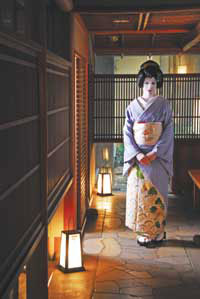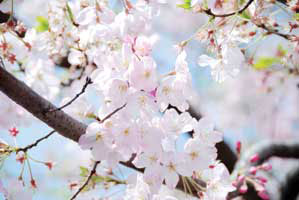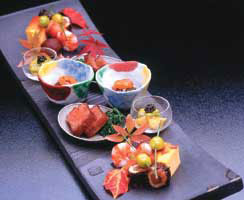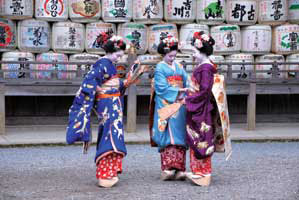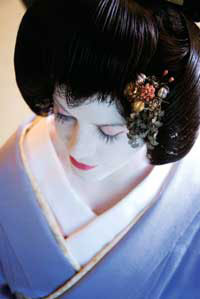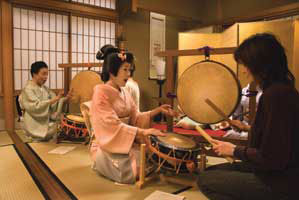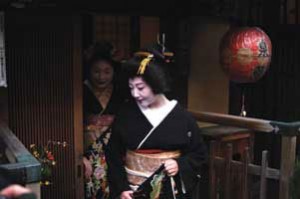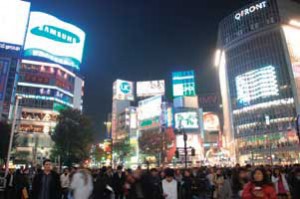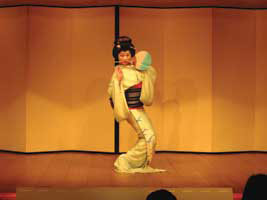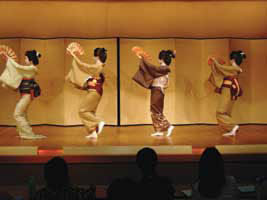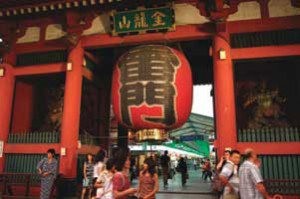For most people in the Western world, the geisha is as quintessentially Japanese as the samurai, sushi and sakura. Yet the 400-year-old world of the geisha remains a mystery even to most Japanese, its doors firmly closed to outsiders until now.
The newest geisha on the block is in fact an Australian – Fiona Graham – who caused a stir in December 2007 when she became the first Western geisha. jstyle reports on her fascinating transformation from Melbourne born schoolgirl to a woman living and breathing this centuries-old Japanese tradition.
Born and raised in Melbourne, Fiona Graham was once a typical Australian schoolgirl with little more than a passing interest in Japan. But when she turned 15, opportunity knocked and she was given the chance to spend a year in Japan as an exchange student. Craving adventure like most teenagers, she decided to go.
“At that time, rather than being interested in Japanese culture, I just knew I really wanted to go somewhere!” she recalls with a laugh. “I didn’t really know anything about Japan. As an exchange student, you get to see the most enjoyable parts of Japan. I was always being taken to lots of interesting places and the whole experience was just so much fun.”
Having gained such a positive first impression, Graham’s interest in Japan and its culture continued and so did her chances to stay there. When she was accepted into Tokyo’s prestigious Keio University (庆应义塾大学) as the first female foreign student, she knew it was an opportunity too good to pass up. She studied psychology and after graduating, began working in Japan. “Before I knew it I had ended up staying in Japan for 10 years straight.”,she says.
Since then, Graham has completed an MBA at Oxford University and a PhD in social anthropology, specialising in Japanese culture. She shares her knowledge and expertise through lecturing, writing books on Japan and making anthropological documentaries, and it was for her latest project that she first stepped onto the path leading to the unique world of the Japanese geisha.
The Western world’s fascination with geisha has reached new heights in recent years with the popularity of Arthur Golden’s novel Memoirs of a Geisha and the 2005 Hollywood film based on the bestseller. While most Australian fans looked forward to seeing the romantic story of the heroine, Sayuri, on the big screen, Graham had a different reaction to the news a film was in the works.
“I knew (the film Memoirs of a Geisha) was being produced by Western men in Hollywood so I knew what sort of movie it was going to be,”she says. Both the film and Golden’s novel are entirely fictional but for Western audiences unfamiliar with the geisha world, it would understandably be difficult to differentiate from reality. This was unacceptable for Graham and motivated her to overturn the enduring stereotype.
“Westerners have a very mistaken image of geisha as women who are completely submissive to men and do exactly as they are told without any will of their own,” Graham says. “Reality is completely different. Geisha are independent working women.”
To tell the world the truth, Graham decided to become a geisha herself and film her experiences inside the geisha world.
From the few remaining geisha districts known as karyuukai (literally “flower and willow world”), Graham chose to undertake her training in the district of Asakusa, one of six “geisha worlds” in Tokyo. When asked why she chose Asakusa and not the better-known Kyoto karyuukai, she offers a number of reasons. “I had only ever lived in Tokyo before, and there was already a book written about the Kyoto geisha world 30 years ago but no books about the Tokyo geisha, so I decided I’d like to stay here (in Tokyo),” she says.
“The Tokyo geisha world also has a lot of history. The Asakusa karyuukai has existed for several hundred years.” Asakusa happens to be the most famous tourist destination in Tokyo, particularly popular with foreigners.
“I think the atmosphere here is the most evocative of old Edo – the Tokyo of the past. It is a really colourful area to film and there are events on every month, in which geisha participate, so I thought that would be really fun.”
No matter what her reasons, the Asakusa geisha world would certainly have been surprised to receive Graham’s application to enter. “It is unprecedented for a foreigner to become a geisha so it wasn’t easy to be accepted,” she says.
“It took some time persuading everyone in the geisha world. Fortunately I had the support of Keio University alumni and people who have a lot of influence in that world. Without that, the world of the geisha would have been quite impossible to enter.”
In the face of Graham’s enthusiasm and the support of those around her, the gates were finally opened. She was introduced to an okiya (a house where a geisha lives, trains and bases herself throughout her career) and commenced geisha training.
Before the war, it was common for girls training to be geisha to enter an okiya from childhood, but according to Graham, the training period in the geisha world of Asakusa today is usually only about one year. During that time, a geisha-in-training will work as a waitress in a traditional restaurant where she can observe and learn from experienced geisha, as well as studying the ancient arts of tea ceremony, dance, taiko (Japanese drum) and yokobue (Japanese flute), and the countless customs and etiquette, which are drummed into her by her “okaasan” (literally “mother”), the head of the okiya.
Graham says she didn’t receive any special treatment because she was a foreigner. “A geisha is a geisha,” she says matter-of-factly. “I don’t sense any difference between them (other geisha) as Japanese and me as a foreigner. We’re all linked by being geisha.”
The hardest part of training for Graham was learning to sit in the seiza position (traditional formal style of kneeling). “Geisha don’t use zabuton (Japanese cushion for sitting),” she says. “An ozashiki (banquet) lasts at least two hours so you need to be able to sit for that length of time. Even if your legs go numb there’s nothing you can do about it so you just have to get used to it quickly. An elderly oneesan (literally “big sister”, used to refer to senior geisha) told me that even being one kilo too heavy makes it hard, so I made an effort to lose weight after that and it became easier.”
Among the traditional arts, Graham was most confident playing yokobue and decided to make that her speciality, but even there she faced challenges. “I had played flute before so I know how to produce a nice sound, but it is still really difficult because the timing of Japanese music is so different to Western music … I still have a long way to go in my training,” she says.
Even for Graham, who had lived in Japan for many years and can speak fluent Japanese, her training was harder than she expected. But last December, having mastered both arts and etiquette, she finally made her official debut as a geisha.
In line with tradition, Graham’s geisha name includes the character “yuki” from her okaasan’s name, Yukiko. On the day of her debut, Graham visited all the senior geisha, okiya, traditional restaurants and teahouses in the Asakusa geisha district, paying her respects to more than 100 people connected with the geisha world before attending her first ozashiki as a professional geisha. And so “Sayuki”, the first foreign geisha, was born.
Today, Sayuki leads a very busy life. Her days typically begin with an hour or two of tutored study in the arts of tea ceremony or dance, followed by more hours of individual practice. A geisha is essentially one who possesses “gei” (arts). As an entertainment and service professional, a geisha has to keep polishing these skills throughout her entire career. Sayuki also participates in the many events held in and around Asakusa, while her evenings are spent attending up to three or four banquet engagements.
Trying to dispel the romanticised idea of geisha as powerless beauties in a male-controlled world, she points out that being a geisha is not unlike an ordinary job. “(Being a geisha) is like being a private businessperson – you have to be quite firm and level-headed. An okiya is basically a business and the okaasan is like the head of a small company. It’s so different to the image of geisha being men’s playthings,” she says.
Sayuki takes obvious pride in belonging to this traditional Japanese profession, which she describes as “the best experience of Japanese culture” and studies diligently everyday.
As for her documentary film, she is using her spare time to film her experiences as a geisha and intends to release the completed work in several countries including Australia. She is also planning a visit to Australia with the other Asakusa geisha as part of her larger goal of introducing geisha culture to the general public.
“I’m trying to teach people about geisha culture. I’m currently hoping for an invitation to Australia so I can visit Japanese Studies departments at Australian universities or participate in festivals and the like,” she says, then adds, “I’d be really grateful for support from any sponsors.”
Having become a geisha for a social anthropological project, Graham won’t retire as soon as her film is finished. “Originally I did start this as a project but I think it’s gone beyond that now,” she says.
“I was able to become a geisha, the first foreigner to achieve that, which is something I’m really thankful for. I feel like I have to make the most of it by working hard to become a first-class geisha.”
Immersed and inspired by this unique element of Japanese culture, Graham, or Sayuki, is taking the historical geisha world into the 21st century.
